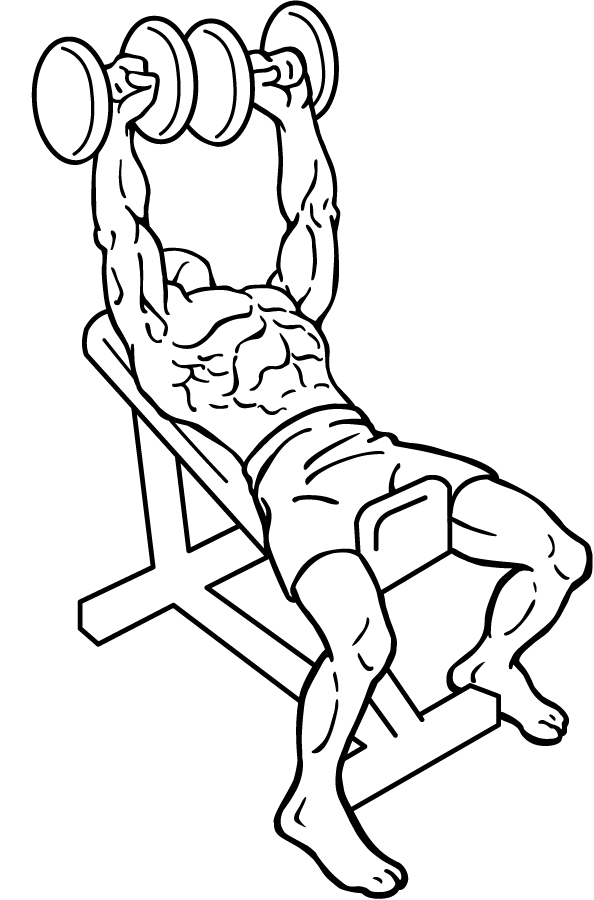Last Updated on September 25, 2014
The dumbbell incline bench press is a powerful exercise that targets multiple muscle groups, making it a staple in advanced strength training routines. This exercise primarily focuses on building and sculpting the chest, but it also engages the triceps and shoulders, contributing to overall upper body strength and aesthetics. In this blog, we will delve into the intricacies of the dumbbell incline bench press, covering its benefits, proper technique, variations, common mistakes, and tips for maximizing your workout.
Benefits of the Dumbbell Incline Bench Press
The dumbbell incline bench press offers several advantages over other chest exercises:
- Targeted Muscle Development: By performing this exercise on an incline bench, you specifically target the upper portion of the pectoral muscles. This helps in achieving a well-rounded chest appearance.
- Improved Shoulder Engagement: The incline angle also places greater emphasis on the anterior deltoids (front shoulder muscles), promoting balanced shoulder development.
- Enhanced Range of Motion: Using dumbbells allows for a greater range of motion compared to a barbell, enabling deeper muscle activation and more effective workouts.
- Stability and Coordination: Each arm works independently with dumbbells, which improves muscular balance and coordination. This can help address any imbalances between the left and right sides of your body.
- Versatility: Dumbbells are versatile tools that can be used for various exercises beyond the incline bench press, making them a valuable addition to any home or gym setup.
Step-by-Step Guide to Performing the Dumbbell Incline Bench Press
To perform the dumbbell incline bench press effectively, follow these detailed steps:
- Setup: Begin by setting an adjustable bench to an incline of approximately 45 degrees. This angle is optimal for targeting the upper chest without placing excessive stress on the shoulders.
- Positioning: Sit on the bench with your feet flat on the ground for stability. Hold a dumbbell in each hand and rest them on your thighs. As you lie back on the bench, use your thighs to help lift the dumbbells to shoulder height.
- Starting Position: With your arms wide and elbows pointing down towards the floor, grasp the dumbbells with a neutral grip (palms facing each other). Ensure that your back is pressed firmly against the bench and your core is engaged.
- Execution: Exhale as you press the dumbbells upward over your chest. As you lift, bring the dumbbells closer together until they nearly touch at the top of the movement. Imagine clapping your hands together to guide their path.
- Peak Contraction: At the top of the movement, squeeze your chest muscles for a moment to maximize muscle engagement.
- Return to Start: Inhale as you slowly lower the dumbbells back to their starting position at shoulder height. Maintain control throughout this phase to ensure safety and effectiveness.
- Repetitions and Sets: Perform 3-4 sets of 8-12 repetitions, adjusting weight as necessary to maintain proper form throughout each set.
Common Mistakes to Avoid
Even seasoned lifters can make mistakes when performing this exercise. Here are some common pitfalls and how to avoid them:
- Incorrect Bench Angle: Setting the bench at too steep an angle can shift focus away from the chest and onto the shoulders excessively. Stick to a 30-45 degree incline.
- Flared Elbows: Allowing your elbows to flare out excessively can increase strain on your shoulder joints. Keep them at about a 45-degree angle relative to your torso.
- Arching Your Back: While some arching is natural, excessive arching can lead to lower back strain. Keep your core engaged and back pressed against the bench.
- Using Momentum: Swinging or jerking weights reduces effectiveness and increases injury risk. Focus on controlled movements with proper form.
Variations of the Dumbbell Incline Bench Press
To keep your workouts varied and challenging, consider incorporating these variations:
- Single-Arm Dumbbell Incline Press: Perform presses one arm at a time to enhance unilateral strength and core stability.
- Incline Dumbbell Flyes: Instead of pressing, open your arms wide in a fly motion for increased pectoral stretch and activation.
- Alternating Dumbbell Press: Press one arm up while keeping the other stationary at shoulder height, then switch.
Tips for Maximizing Your Workout
To get the most out of your dumbbell incline bench press routine, consider these tips:
- Warm-Up Properly: Engage in dynamic stretches or light cardio before lifting to prepare your muscles.
- Progressive Overload: Gradually increase weight or repetitions over time to continue challenging your muscles.
- Focus on Form Over Weight: Prioritize maintaining proper technique rather than lifting heavier weights with poor form.
- Rest Adequately Between Sets: Allow sufficient rest (60-90 seconds) between sets for optimal performance.
The dumbbell incline bench press is an essential exercise for anyone looking to build a strong, sculpted upper body. By following proper technique and incorporating variations into your routine, you can effectively target multiple muscle groups while minimizing injury risk. Remember that consistency is key; progress may be gradual but with dedication and attention to detail, you’ll see significant improvements in strength and muscle definition over time. Whether you’re training at home or in a gym setting, this versatile exercise will undoubtedly contribute to achieving your fitness goals.


Exercise images by Everkinetic.





